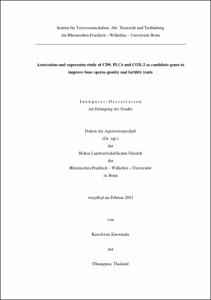Kaewmala, Kanokwan: Association and expression study of CD9, PLCz and COX-2 as candidate genes to improve boar sperm quality and fertility traits. - Bonn, 2011. - Dissertation, Rheinische Friedrich-Wilhelms-Universität Bonn.
Online-Ausgabe in bonndoc: https://nbn-resolving.org/urn:nbn:de:hbz:5N-24862
Online-Ausgabe in bonndoc: https://nbn-resolving.org/urn:nbn:de:hbz:5N-24862
@phdthesis{handle:20.500.11811/4720,
urn: https://nbn-resolving.org/urn:nbn:de:hbz:5N-24862,
author = {{Kanokwan Kaewmala}},
title = {Association and expression study of CD9, PLCz and COX-2 as candidate genes to improve boar sperm quality and fertility traits},
school = {Rheinische Friedrich-Wilhelms-Universität Bonn},
year = 2011,
month = apr,
volume = 152,
note = {The transcription factors tetraspanin CD9 (CD9), phospholipase C zeta (PLCz) and cyclooxygenase isoenzyme type 2 (COX-2) are believed to play a key role in spermatogenesis in rat, mouse and human. However, no study was devoted to associate the single nucleotide polymorphism (SNP) and expression pattern of three genes with sperm quality and fertility traits in boars. Therefore, this study aimed to investigate the polymorphism and expressional pattern of these genes with boar sperm quality and fertility. The association of SNP with sperm quality traits (sperm concentration [SCON], semen volume per ejaculate [VOL], sperm motility [MOT], plasma droplets rate [PDR] and abnormal spermatozoa rate [ASR]) and the fertility traits (non return rate [NRR] and number of piglet born alive [NBA]) were analyzed using 231 of purebred Pietrain (PI) boars, 109 of Pietrain × Hampshire crossbred (PIHA) boars and 340 of the combined analysis from PI and PIHA boars (COMBINED). In addition, to study the mRNA and protein expression pattern of those genes in boar reproductive and non reproductive tissue, three boars having higher sperm concentration, sperm motility and lower sperm volume (G-I groups) and three boars having lower sperm concentration, sperm motility, and higher sperm volume (G-II groups) were selected. The result showed that the SNP in intron 6 (A>T) of CD9 was significantly associated with MOT (p < 0.05) and PDR (p < 0.05) in all groups and only with ASR (p < 0.01) in the PIHA group and the COMBINED group. Moreover, the SNP in intron 1 (A>C) of PLCz was associated with SCON (p < 0.05) in the PIHA group. However, the SNP in intron 9 (G>A) of COX-2 showed no association with sperm quality and fertility traits. In addition, the mRNA and protein expression of the CD9, PLCz and COX-2 were found to be different between reproductive tissues and non reproductive tissues of boars. Elevated CD9, PLCz and COX-2 proteins expression were found in Leydig cells, Sertoli cells, epithelial cells, germ cells and the acrosome and acrosomal membrane of mature spermatozoa. Importantly, higher CD9 and PLCz mRNA (p < 0.05) was found in body of epididymis and testis in G-I compared to G-II boars. However, the expression of COX-2 in testis, head and body of epididymis was higher (p < 0.05) in G-II compared to G-I boars. Therefore, the present study may indicate that the CD9, PLCz and COX-2 genes are involved in the spermatogenesis of male pig.},
url = {https://hdl.handle.net/20.500.11811/4720}
}
urn: https://nbn-resolving.org/urn:nbn:de:hbz:5N-24862,
author = {{Kanokwan Kaewmala}},
title = {Association and expression study of CD9, PLCz and COX-2 as candidate genes to improve boar sperm quality and fertility traits},
school = {Rheinische Friedrich-Wilhelms-Universität Bonn},
year = 2011,
month = apr,
volume = 152,
note = {The transcription factors tetraspanin CD9 (CD9), phospholipase C zeta (PLCz) and cyclooxygenase isoenzyme type 2 (COX-2) are believed to play a key role in spermatogenesis in rat, mouse and human. However, no study was devoted to associate the single nucleotide polymorphism (SNP) and expression pattern of three genes with sperm quality and fertility traits in boars. Therefore, this study aimed to investigate the polymorphism and expressional pattern of these genes with boar sperm quality and fertility. The association of SNP with sperm quality traits (sperm concentration [SCON], semen volume per ejaculate [VOL], sperm motility [MOT], plasma droplets rate [PDR] and abnormal spermatozoa rate [ASR]) and the fertility traits (non return rate [NRR] and number of piglet born alive [NBA]) were analyzed using 231 of purebred Pietrain (PI) boars, 109 of Pietrain × Hampshire crossbred (PIHA) boars and 340 of the combined analysis from PI and PIHA boars (COMBINED). In addition, to study the mRNA and protein expression pattern of those genes in boar reproductive and non reproductive tissue, three boars having higher sperm concentration, sperm motility and lower sperm volume (G-I groups) and three boars having lower sperm concentration, sperm motility, and higher sperm volume (G-II groups) were selected. The result showed that the SNP in intron 6 (A>T) of CD9 was significantly associated with MOT (p < 0.05) and PDR (p < 0.05) in all groups and only with ASR (p < 0.01) in the PIHA group and the COMBINED group. Moreover, the SNP in intron 1 (A>C) of PLCz was associated with SCON (p < 0.05) in the PIHA group. However, the SNP in intron 9 (G>A) of COX-2 showed no association with sperm quality and fertility traits. In addition, the mRNA and protein expression of the CD9, PLCz and COX-2 were found to be different between reproductive tissues and non reproductive tissues of boars. Elevated CD9, PLCz and COX-2 proteins expression were found in Leydig cells, Sertoli cells, epithelial cells, germ cells and the acrosome and acrosomal membrane of mature spermatozoa. Importantly, higher CD9 and PLCz mRNA (p < 0.05) was found in body of epididymis and testis in G-I compared to G-II boars. However, the expression of COX-2 in testis, head and body of epididymis was higher (p < 0.05) in G-II compared to G-I boars. Therefore, the present study may indicate that the CD9, PLCz and COX-2 genes are involved in the spermatogenesis of male pig.},
url = {https://hdl.handle.net/20.500.11811/4720}
}






